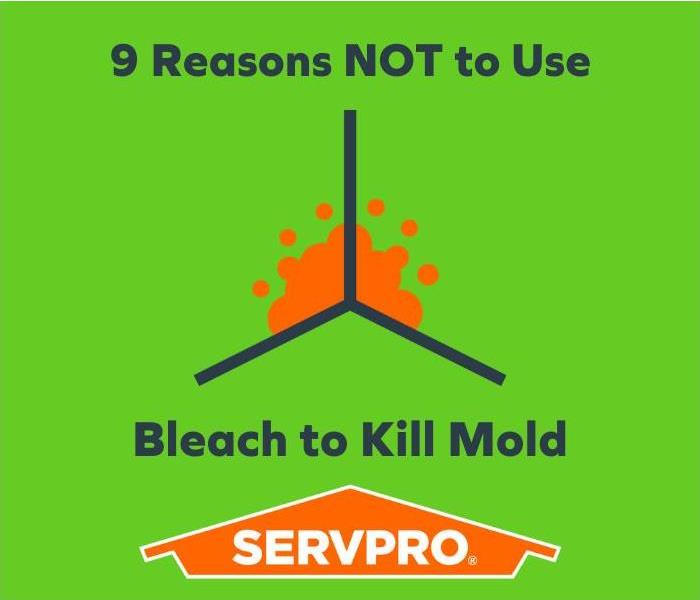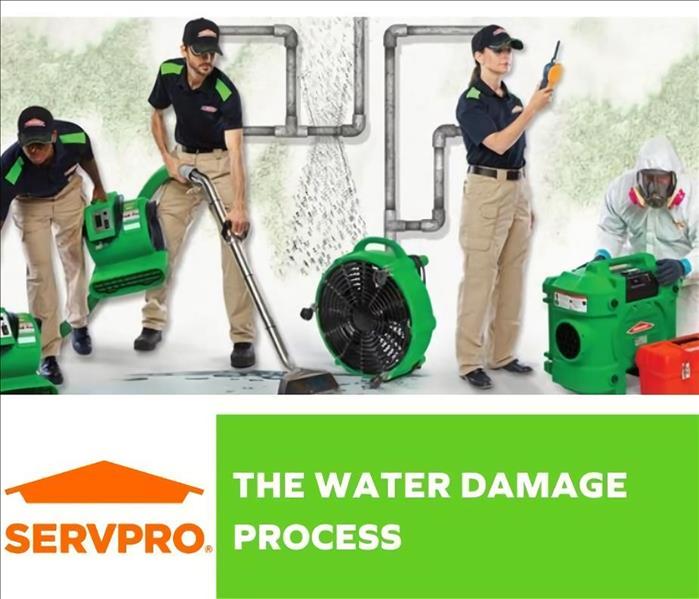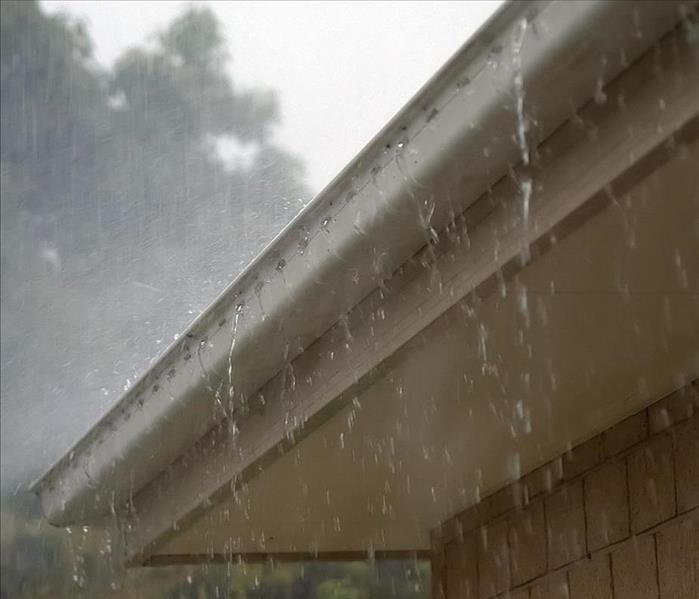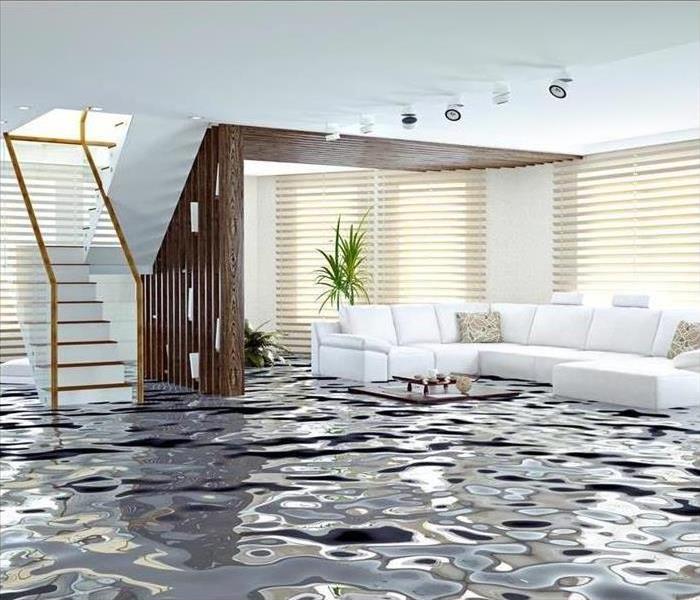Archived Water Damage Blog Posts
9 Reasons NOT to Use Bleach to Kill Mold
6/8/2022 (Permalink)
The use of Bleach is a well-known all-purpose cleaning agent that has been widely distributed by DIY blogs and even notable websites such as Huffington Post. This is especially true when it comes to cleaning Mold.
The truth of the matter is that using chlorine bleach may cause more damage than good.
The Occupational Safety and Health Administration (OSHA) as well as the Environmental Protection Agency (EPA), recommend NOT using bleach to kill mold.
Here are 9 Reasons NOT to Use Bleach to Kill Mold:
1. Bleach introduces excess moisture on porous surfaces. A Bleach cleaning solution can contain up to 90% water. Chlorine quickly evaporates leaving the water that soaks into porous surfaces like wood. This encourages mold growth.
2. Bleach will not kill the roots or hyphae. On a porous surface, bleach will wipe away the visible mold, but will not penetrate the many roots caused by the mold.
3. The EPA and OSHA specifically advise against using bleach for mold remediation. High-level organizations focused on public health & safety set the standard for not using bleach as a mold cleaning agent.
4. Bleach is harmful and corrosive. Bleach will weaken wood and metal, breaking down the fibers and corroding metal.
5. Bleach is an irritant. Bleach releases chlorine gas, causing damage to skin, eyes, lungs, and even clothing.
6. When mixed, bleach can be deadly. Mixing bleach with other cleaners or acids can release deadly gases that can kill if inhaled.
7. Inactivation by Organic Matter. Bleach quickly loses its strength after being exposed to heat or light. Because of that, it doesn't prevent future microbial growth.
8. Most bleach products are not on the EPA Approved List of antimicrobial agents. This list features cleaning agents approved for commercial or residential use.
9. Approved antimicrobial alternatives are readily available. These agents are specifically designed to kill mold and prevent microbial growth. They tend to be cost-effective, safe, and easy to use.
Mold is not a DIY job. If you suspect mold at your Southern California commercial or residential property, SERVPRO® of Tustin works to remediate mold from the source. Call us, (714) 480-1340
SERVPRO® of Tustin are your Mold Professionals. Call us to schedule an appointment, (714) 480-1340
The Water Damage Process
5/3/2022 (Permalink)
Water Restoration Process
Water damage to your property can be a stressful & confusing event. SERVPRO® is here for the clean-up. The sooner you begin cleanup, the less likely you are to have secondary problems, such as mold growth. The following steps will guide you through the restoration process.
Addressing the Water Source
Flooding may be due to broken pipes, a leaky roof, or other causes. The flow of water must be stopped before beginning clean-up. Although a temporary solution may allow you to get started on the restoration process, it is important to fully repair the problem to prevent future flooding.
Remove Standing Water
To remove standing water SERVPRO® uses specialized water extractors. These extractors remove large amounts of water without damaging your carpet or flooring at your property.
The Dry Out
To completely dry the areas, Air Movers and Dehumidifiers are used to control airflow and climate. A drying system is then implemented to ensure your property dries as quickly and effectively as possible.
Sanitize Areas
Cleaning and sanitation efforts take place after the area is dried out. Anti-bacterial cleaners are used to sanitize and clean the area.
SERVPRO of Tustin is here to help with all your water damage needs. We are open 24/7 365 days a year to help you get back to normal. Call us at (714) 480-1340
Water Damage From Garden Hose
5/1/2022 (Permalink)
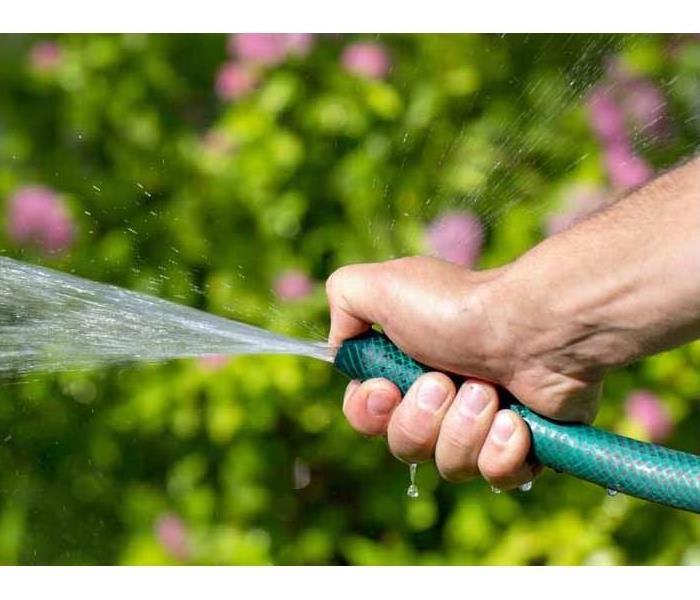 A regular garden hose can spill 24 gallons of water per minute!
A regular garden hose can spill 24 gallons of water per minute!
Summer is right around the corner, and for most people, it means spending more time outside. Whether that time is spent watering your garden, hooking up a slip n slide, or filling up an inflatable pool, they all require a garden hose. A 25-foot, 1/2-inch hose with water at 40 psi has a flow rate of 24 GALLONS per minute. That is a lot of water in a not too long period of time, especially when you think of how much can come out in an hour. That is why it is EXTREMELY important to make sure that when watering your garden or plants that you not forget about your hose and accidentally leave it running. Walking away from your hose while it is on can cause water to saturate the ground around your home causing mold and potentially even damaging your foundation!
A leaking garden hose can cause extensive water damage to your home due to the long period of time that the water might be entering your home. Here are some tips for things to look for when you come across a leaky hose or faucet, and how you can stop the water from damaging your home.
First and foremost, determine where the leak on your hose is actually coming from. Finding the source of the leak should be relatively easy, but depending on the location of said leak will determine the severity of the problem and how much effort it will take to fix it. If your hose is leaking from the connection to the faucet, your problem likely lies with either the spigot itself or the hose fitting. If water is coming up from around the handle, most likely your packing washer is worn out, or the packing nut may need to be tightened. However, if water only leaks when your hose is secured to the spigot, then you need to check to see if water is leaking around the actual connection, or from below the fitting, in which case you may need a new hose.
When a disaster strikes, SERVPRO® is there to clean up the mess. Call SERVPRO® of Tustin, Orange/ Villa Park, Santa Ana, Irvine/ Foothills Ranch for your disaster recovery needs. From Fire and Water damage to sanitization, we are there to assist you. Call us at: (714) 480-1340
After a Water Damage, Should You Clean Mold Yourself?
4/19/2022 (Permalink)
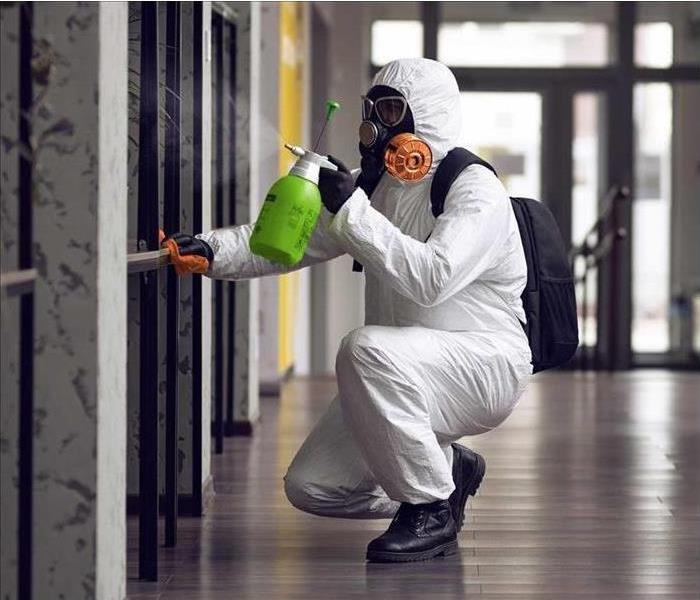 SERVPRO has specialized in mold removal for over 50 years
SERVPRO has specialized in mold removal for over 50 years
Discovering any type of mold on your property can seem like the end of the world. Professionals can do things to either reduce, or remove it completely, and give you back your peace of mind. You may be wondering, 'If I do nothing will the mold go away on its own? or Can I clean it myself?' Consider how mold behaves and how to get rid of it.
Common Causes
Mold grows on organic materials and thrives in dark and moist environments. Some of the common causes include but are not limited to:
- Plumbing Leaks
- Roof Leaks
- Condensation
- Humidity
- Flooding
- Water Damage
- Etc.
DIY
While there are many DIY solutions to dealing with mold, most commonly using bleach, those aren't usually effective. This is especially true on porous surfaces, where mold is typically found, as it spreads deep into the material where the cleaning solution can't reach. Your safest solution is to call a professional who is certified and experienced in mold cleanup.
Remediation
The best way to ensure mold is fully gone is to call a Mold Remediation Specialist. SERVPRO has specialized in mold removal services for over 55 years. We have a qualified, experienced team of professionals that have the right equipment and techniques to safely and thoroughly remove mold from your property. We can show up any time of day or night, address the severity of the mold growth, and create a plan to get rid of it with as few disruptions to your life as possible.
SERVPRO® of Tustin, Orange/Villa Park, Irvine North, & Santa Ana Central are your Mold Professionals. Call us to schedule an appointment, at (714) 480-1340
Customers Ask: "Can I Shut Off the Drying Equipment?"
4/12/2022 (Permalink)
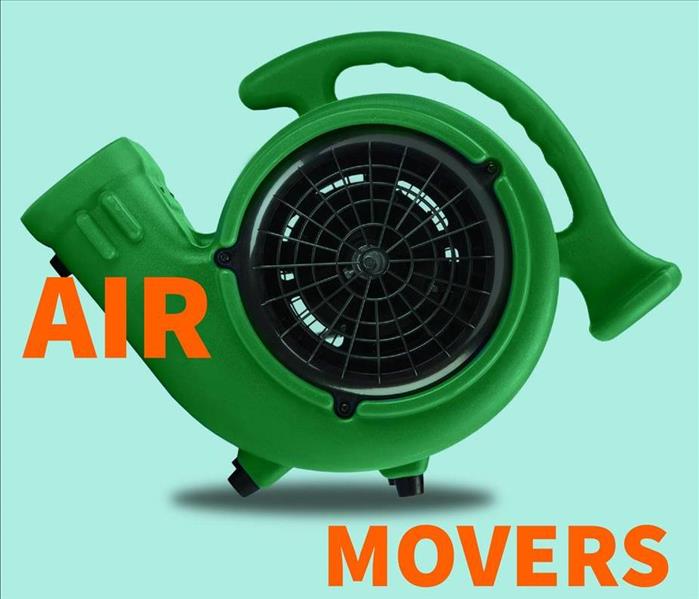 Should you turn the equipment off?
Should you turn the equipment off?
An integral part of the water damage process is setting up drying systems. These drying systems involve strategically placed equipment for optimal drying. Equipment is essential in drying out the affected areas. But many customers ask, "can I shut off the equipment? It's too loud!" What if the noise is disturbing your peace?
Can I Turn Off the Drying Equipment?
You should refrain from turning off the equipment without consulting the lead technician first. These machines are necessary to dry out your property as quickly as possible. Turning the equipment off can prolong the job and could require a longer dry time at your property.
In order to determine the correct amount of equipment to place, our skilled crews follow IICRC guidelines that determine industry standards.
A water loss doesn't have to be a headache. Let SERVPRO® of Tustin take care of it, we'll get your property looking "Like it never even happened." (714) 480-1340
Water-damaged Hardwood Floor in Tustin?
7/5/2021 (Permalink)
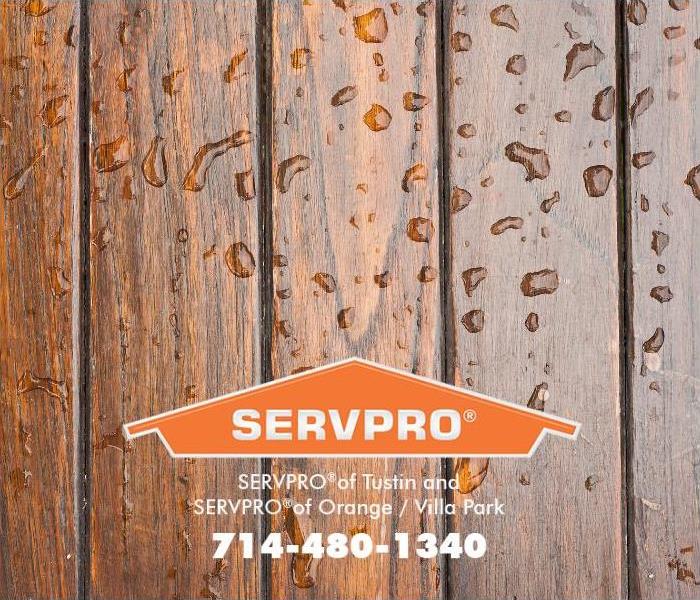 We are trusted leaders in water restoration services in Orange County.
We are trusted leaders in water restoration services in Orange County.
SERVPRO® of Tustin and SERVPRO® of Orange/Villa Park know the importance of mitigating water damage quickly. The longer water is allowed to remain standing, the more time-consuming and expensive the repairs will be. Here is a timeline that describes the damage water can do to a structure within one week:
Water Damage Timeline
Within Minutes
- Water quickly spreads throughout your property, saturating everything in its path
- Water is absorbed into walls, floors, upholstery, and belongings
- Furniture finishes may bleed, causing permanent staining on carpets
- Photographs, books, and other paper goods start to swell and warp
Hours 1 - 24
- Drywall begins to swell and break down
- Metal surfaces begin to tarnish
- Furniture begins to swell and crack
- Dyes and inks from cloth and paper goods spread and stain
- A musty odor appears
48 Hours to 1 Week
- Mold and mildew may grow and spread
- Doors, windows, and studs swell and warp
- Metal begins to rust and corrode
- Furniture warps and shows signs of mold
- Paint begins to blister
- Wood flooring swells and warps
- Serious biohazard contamination is possible
Call Us!
SERVPRO® of Tustin and SERVPRO® of Orange/Villa Park is on-call 24-hours a day in Tustin to respond to water damage emergencies. Call us today at 714-480-1340.
Franchises are Independently Owned and Operated.
Flooded Bathroom in Tustin Ranch?
5/3/2021 (Permalink)
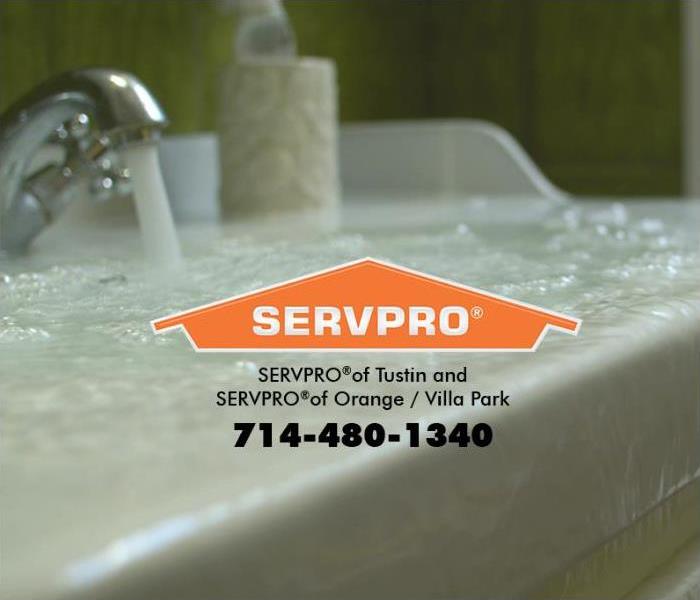 We are trusted leaders in water damage mitigation in Orange County.
We are trusted leaders in water damage mitigation in Orange County.
Trouble in Tustin Ranch.
My son finally reached the age where he could brush his teeth and wash up without my supervision. It was great to know that another milestone had been reached. One morning we were running late, and I called him down and we rushed out the door. When we came home a couple of hours later the house was flooded. Water was cascading down the stairs! I ran up and discovered that the water had been left on in the upstairs bathroom sink and a washcloth was plugging the drain, which caused the water to overflow from the bathroom sink.
I called SERVPRO® of Tustin and SERVPRO® of Orange/Villa Park. The technicians arrived quickly and extracted the water and set up powerful air blowers and movers to dry the upstairs and downstairs areas that were flooded. Thanks to their fast response the floors were not damaged and there was no damage to the walls and baseboards. They documented the drying process and cleaned, sanitized, and deodorized the affected areas.
Step 1: Emergency Contact
Step 2: Inspection and Damage Assessment
Step 3: Water Removal/Water Extraction
Step 4: Drying and Dehumidification
Step 5: Cleaning and Repair
Step 6: Restoration
Call Us!
When you have a water damage emergency, SERVPRO® of Tustin and SERVPRO® of Orange/Villa Park are ready to respond 24-hours a day. Call us today at 714-480-1340. We’ll clean and restore your water damage in Tustin Ranch, “Like it never even happened.”
SERVPRO of Tustin and SERVPRO of Orange/Villa Park are Independently Owned and Operated.
Burst Pipe in Portola Hills?
4/26/2021 (Permalink)
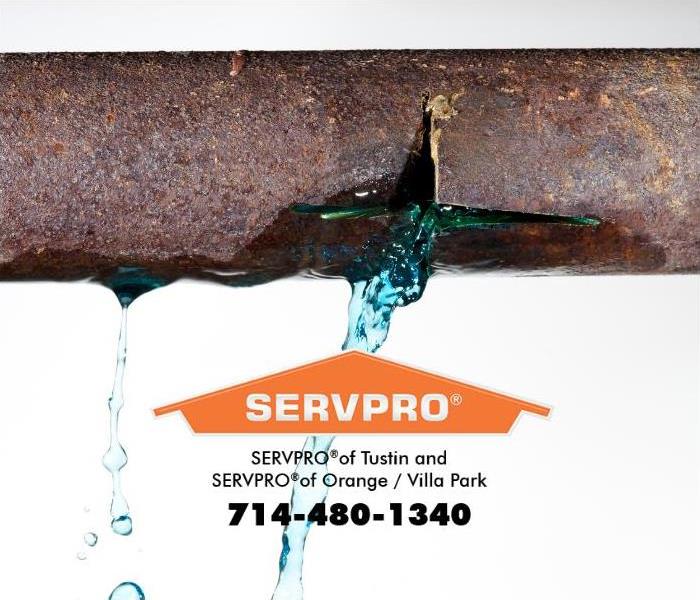 We respond to water damage emergencies 24-hours a day in Orange County.
We respond to water damage emergencies 24-hours a day in Orange County.
Is your water bill too high in Portola Hills?
My water bill was unusually high, but I didn’t see any visible signs of water damage until I noticed a funny, musty smell coming from my wall. A pipe was leaking inside my wall and had been for over a month before the damage was discovered. I called SERVPRO® of Tustin and SERVPRO® of Orange/Villa Park, and they sent a team of water restoration technicians out to fix the leak and restore the damage to the wall.
Here are some tips from the Environmental Protection Agency for finding water leaks in your home:
- Take a look at your water usage during a colder month, such as January or February. If a family of four exceeds 12,000 gallons per month, there are serious leaks.
- Check your water meter before and after a two-hour period when no water is being used. If the meter changes at all, you probably have a leak.
Call Us!
SERVPRO® of Tustin and SERVPRO® of Orange/Villa Park have a team of highly trained restoration technicians on-call 24-hours a day to respond to your call. Call us today at 714-480-1340. We’ll clean and restore your water damage in Portola Hills, “Like it never even happened.”
SERVPRO of Tustin and SERVPRO of Orange/Villa Park are Independently Owned and Operated.
Flooded Bathroom in Tustin?
4/19/2021 (Permalink)
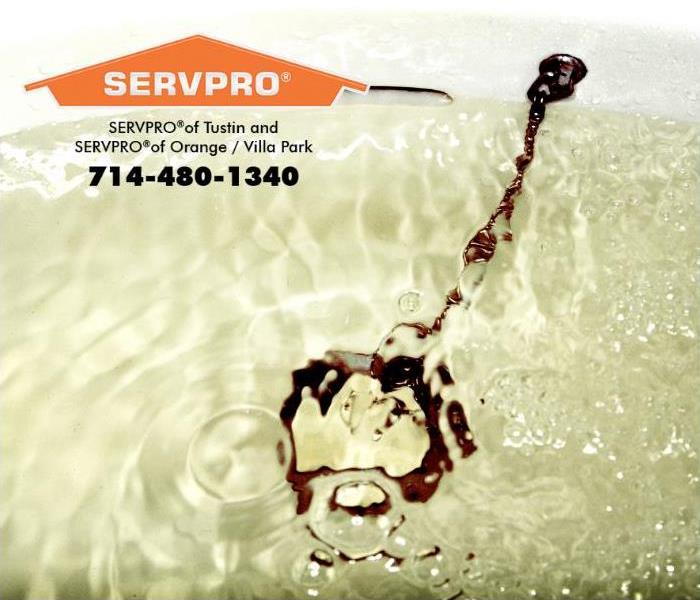 We are trusted leaders of water damage mitigation in SERVPRO of Tustin and SERVPRO of Orange / Villa Park.
We are trusted leaders of water damage mitigation in SERVPRO of Tustin and SERVPRO of Orange / Villa Park.
Sinking Feeling in Tustin?
I was down in my office for a couple of hours on a conference call before I heard a funny dripping and splashing sound coming down the stairs. When I investigated, I discovered that my daughter had left the sink running in my Tustin home. There was a shallow lake in the bathroom, and water was running down the hallway. The stairway carpeting was saturated. My neighbor told me to call SERVPRO of Tustin and SERVPRO of Orange / Villa Park, and I’m glad I did.
I was amazed at how quickly the SERVPRO of Tustin and SERVPRO of Orange / Villa Park, technicians arrived. They quickly extracted the water and set up powerful air blowers and movers to dry the upstairs and downstairs areas that were flooded. Thanks to their fast mitigation, the floors were not warped or damaged, and there was no damage to the walls and baseboards. They documented the drying process and cleaned, sanitized, and deodorized the affected areas.
Step 1: Emergency Contact
Step 2: Inspection and Damage Assessment
Step 3: Water Removal/Water Extraction
Step 4: Drying and Dehumidification
Step 5: Cleaning and Repair
Step 6: Restoration
Call Us!
When you have a water damage emergency, SERVPRO of Tustin and SERVPRO of Orange / Villa Park are ready to respond 24-hours a day. We’ll clean and restore your water damage in Tustin, “Like it never even happened.”
SERVPRO of Tustin and SERVPRO of Orange / Villa Park are Independently Owned and Operated.
Contents Restoration Services in Tustin?
4/19/2021 (Permalink)
 We are leaders in water damage restoration in Tustin.
We are leaders in water damage restoration in Tustin.
When my Tustin home basement flooded, we were out of town, and the damage wasn’t discovered for a few days. Everything that touched the ground was damaged by water. All the furniture and cardboard boxes stored down in the basement were standing in water. My insurance adjuster told me to call SERVPRO of Tustin and SERVPRO of Orange / Villa Park.
The SERVPRO of Tustin and SERVPRO of Orange / Villa Park technicians arrived quickly, assessed the situation, and immediately began the cleanup and restoration process. They contacted my insurance adjuster and helped me with the insurance paperwork and process. Fortunately, they were able to clean and restore most of the items from my basement and return them to preloss condition. Here are the cleaning methods they used:
- Dry Cleaning - used for cleaning light residues or to pre-clean prior to wet cleaning
- Wet Cleaning - an effective cleaning method for removing moderate to heavy residues
- Spray and Wipe - effective for items that can’t withstand wet cleaning
- Foam Cleaning - used for upholstery fabrics that might shrink or bleed if wet cleaned
- Abrasive Cleaning - involves agitation of the surface being cleaned
- Immersion Cleaning - contents are dipped into a bath of the cleaning product
Call Us Today!
SERVPRO of Tustin and SERVPRO of Orange / Villa Park has a team of highly trained technicians with specialized training and experience to clean and restore your keepsakes. We’ll restore your water damage in Tustin, “Like it never even happened.”
SERVPRO of Tustin and SERVPRO of Orange / Villa Park are Independently Owned and Operated.
Commercial Flood Insurance in SERVPRO of Tustin and SERVPRO of Orange / Villa Park
4/13/2021 (Permalink)
The National Flood Insurance Program (NFIP) provides flood insurance. The NFIP doesn’t sell insurance. Buy flood insurance from an insurance agent.
SERVPRO of Tustin and SERVPRO of Orange / Villa Park is interested in helping the businesses in our community become more educated on flood insurance. According to FEMA, 40% of small businesses do not reopen after experiencing a devastating flood.
Things to know in Tustin. Check to see if you might be required to have flood insurance.
- All agencies in Tustin charge the same for flood insurance
- Standard commercial insurance doesn’t pay for flood damage
- The NFIP sets the rates
- Rates depend on:
- whether you live in a flood plain
- flood risk in your area
- building’s age
- building’s construction
- Building property insurance covers the building
- Personal property insurance covers the building’s contents
- NFIP suggests you need both types
- Policies go into effect 30 days after purchase
- The NFIP help center number is 1-800-427-4661
SERVPRO of Tustin and SERVPRO of Orange / Villa Park recommends the following:
- Check whether or not your area participates in the NFIP
- Check whether or not your area is part of the Community Rating System. The NFIP might have a discount
- Talk to your insurance agent when you need to make changes
Make sure your business is protected from the devastation that comes with unwanted flooding in your office.
SERVPRO of Tustin and SERVPRO of Orange / Villa Park are Independently Owned and Operated.
***
Links:
https://www.usa.gov/property-insurance
www.fema.gov
Staying Healthy Around Standing Water in Tustin
4/13/2021 (Permalink)
Staying Healthy Around Standing Water in Tustin:
Standing water of any kind in Tustin can be a powerful source of disease. Floods can be worse due to the amount of water involved. Even small puddles can pose a risk.
Different kinds of debris can be found in flood water such as dead animals, rotted plants, and sewage, to name a few. If you have water damage inside your home, watch for debris in the home as well to include rotted food and electrical problems.
Viruses and bacteria can cause illnesses. To reduce your chances of catching something, SERVPRO of Tustin and SERVPRO of Orange / Villa Park suggests:
- Washing dirty clothes and towels in hot water. Use bleach if possible
- Remember that you can shake hands with an infected person and get infected.
- Do not allow children to play in the flood water
- Wash children’s hands before meals
- Disinfect toys before letting children play with them
- Use bleach or other disinfectants on hard surfaces
- Keep your hands washed
Cuts and rashes can become infected. Protect yourself and others in Tustin:
- Avoid floodwaters if you have an open rash or a cut
- Clean cuts or rashes. Cover them with a waterproof bandage
- Clean cuts with soap and clean water
- If a cut becomes red, swollen, or is oozing, get medical attention
SERVPRO of Tustin and SERVPRO of Orange / Villa Park are Independently Owned and Operated.
***
Links:
https://www.cdc.gov/healthywater/emergency/extreme-weather/floods-standingwater.html
Things to do for Water Damage Until Help Arrives in Tustin
4/12/2021 (Permalink)
If your home or business in Tustin has water damage, you can do some things before help arrives.
Make sure that the building or home is safe.
SERVPRO of Tustin and SERVPRO of Orange / Villa Park Wants You to Remember:
- Waterlogged materials are very heavy
- Wet surfaces are slippery
- Make sure electrical power is off before you handle devices
- Make sure you are standing in a dry area before you turn on the electric power
SERVPRO of Tustin and SERVPRO of Orange / Villa Park suggests that you:
- Remove excess water with mops and/or towels
- Wipe water from wood furniture or other items
- Remove wet cushions. Prop them upright to dry
- Hang up rugs to dry
- Place foil or blocks between furniture and wet carpeting
- Turn on dehumidifiers or air-conditioning if it is safe
- Move colored items from wet carpeting
- Move artwork to a safe, dry place
- Move loose items from the floor or counters
- Start drying items ASAP
- Remember that mold starts growing within 24 hours
- Stay away from rooms that have sagging ceilings
SERVPRO of Tustin and SERVPRO of Orange / Villa Park are independently owned and operated.
Tips for Standing Water in Tustin
4/12/2021 (Permalink)
A flood doesn’t end once the storm stops. We still have to deal with all that standing water. The floodwater can take up to 11 days to disappear. It’s not time to go fishing.
If you have to evacuate your office, do not go back until you have been told it is safe.
Be careful driving in Tustin. Remember to “Go around. Don’t Drown!” The water may still be too deep for safe travel.
Floods are not natural swimming pools
- Sewage, debris, and other unpleasant things can be in the storm water leftovers
- Swimming, wading, or rafting can make you sick
- Don’t drink the water
- Water conducts electricity. Underground power lines can give you a dangerous shock
Floodwaters vs. Animals in Tustin:
- Snakes and other animals may get into your building. Wear work boots and heavy gloves when you clean up
- Some animals might find your office a cozy place to live
- If tap water is unsafe to drink, it is unsafe for your pets
Link:
https://www.ready.gov/floods
Do You Have Water Damage To Your Hardwood Floors?
2/26/2020 (Permalink)
Hardwood floors are a popular flooring option for many homeowners due to their aesthetic as well as the relatively low maintenance required. While hardwood floors are extremely durable, they can be quite vulnerable to moisture. If your home has hardwood floors, it is important that you are always on the lookout for signs of water damage to the wood flooring.
A very common sign of water damage in hardwood floors in known as cupping. This occurs when moisture causes the wood to expand, which then pushes the boards together and deforms them in the center. Another common sign of water damage in wood floors is called crowning. Crowning is essentially the opposite of cupping. While cupping causes a depression in the center of the wood planks, crowning is when the boards are pushed together and result in a raise in the center of the wood boards. Both cupping and crowning can lead to a buckling floor if left unchecked. Buckling is when the floor boards have actually begun lifting from the subfloor, causing considerable damage to your wood floor.
Other signs to be aware of are if the floor starts to crack, the boards are separating, or the wood becomes soft and weak. If you notice any of these signs occurring in your wood floor, you have wood floor water damage, and need to take action to prevent further damage.
The first step in preventing further water damage is to determine the source of the damage. If you have an active leak, it is best to turn of the water to the home and have a leak detector or plumber inspect to determine the cause of leak and make a repair.
You should also call SERVPRO right away to begin the mitigation services. If the floor is salvageable, we can place drying equipment (including a floor drying mat system) to repair the damaged floor to its preloss condition.
If you think your home may be affected by a water damage, give SERVPRO of Tustin a call today! 714-480-1340
Everything You Need To Know About Slab Leaks
1/15/2020 (Permalink)
According to the National Association of Home Builders, nearly 96% of Californian residents live in homes that were built on a concrete slab of foundation. This slab of concrete is the support and main structure for your entire home, so as you can imagine, it is imperative that it is kept in good shape. This is one reason understanding what a slab leak is and knowing how to spot one is so important, especially for residents of California.
We’ve created a fact sheet about slab leaks so that you can keep your home in tip-top shape. Keep reading for a list of everything you’ll ever need to know about slab leaks!
What Are Slab Leaks?
A slab leak is the shorthand term professionals use when referring to leaking water pipes underneath a house. Typically, these copper pipers are buried beneath slabs of concrete located underneath the foundations of your house. Unfortunately, this means that they can go unnoticed for an extended period of time. However, as the water damage builds up, soaking away at the understructure of your home, these slab leaks can do considerable damage to the exterior over time. Obviously, this is not a good situation for any homeowner.
What Causes Slab Leaks?
Water pipes often use copper because it is resistant to water erosion. However, nothing lasts forever, and resistant does not mean invulnerable. As time goes on the copper in the pipes becomes increasingly corroded. Eventually, cracks and holes start to develop. When these appear in above-ground pipes, they are called pinhole leaks, but underground where they can go undetected for months they cause much more damage.
Alternative Causes
Other causes include things like earthquake damage or less severe forms of ground shifts, both of which are very common in California. When the surrounding soil shifts erratically, it can put pressure on the pipes from multiple different directions, leading to stress fractures and warping of the metal.
Damage could also be caused by natural abrasion as the pipes shift and grind against exposed surfaces. This is a common issue if pipes were buried too close to the concrete above, or even one another.
Another alternative is that the pipes were simply installed improperly, or suffered damage during the installation process. Minor gaps or dents may seem like nothing but can become significant as time and pressure work on them.
Slab Leak Indicators
These leaks typically start small and, because the leaking pipes are buried under thick concrete, are not always easy to detect. However, there are a couple of signals homeowners should know so they can more easily spot a slab leak before it becomes a bigger problem. These signs include:
- Mold or mildew growth or a general musty smell
- Moisture under the carpets
- Low water pressure
- Puddles of water in your yard or near the base of your house
- Pipes or water meters active when not in use
- Sudden jump up in your water bill
Understanding these indicators and knowing what to look out for can save you a massive headache and significant repair bills in the future, so keep this list as a reference.
If you notice any of the above factors or have noticed any weird occurrences with your plumbing, then don’t hesitate to reach out to a professional for help. At SERVPRO Of Tustin, we understand the stress of having to deal with major home issues, so we do our best to make it easy for you. Don’t hesitate to contact us for an appointment at 714-480-1340
What Causes Residential Water Damage?
1/15/2020 (Permalink)
The last thing any of us want is water damage in our homes, and often times we take for granted the protection from the elements that our homes provide. When any kind of damage is spotted, it’s best to act as quickly as possible to stop it from causing more issues. Proactively addressing the problem can not only save the home’s appearance but can also save you a lot of money. It is also essential that homeowners know what can cause residential water damage so that precautionary measures may be taken.
Common Causes Of Water Damage
- Wind, rainstorms, and other natural disasters, such as flooding
- Leaks from a damaged roof
- Water draining onto the home’s structure from clogged gutters
- Broken or old windows that aren’t properly sealed lead to potential leaks
- Leaky faucets, burst pipes, slab leaks & other plumbing issues
Roof Damage
The signs that there is damage to the roof are often visible, but the cause of the damage isn't always evident to an untrained eye. Strong winds can loosen shingles in the roof, causing the under material to be exposed, which can cause a leak. Additionally, hail can cause abrasions and holes in the roof that may be too small to see, but that can cause significant damage or even shatter the shingles altogether.
Clogged Gutters
Not taking the time to clean the gutters can be a costly mistake. When gutters are clogged water sits against the roof and can cause the roof to rot. If the damage is severe enough, the entire roof may need to be replaced. Water from clogged gutters can spill over the sides of the gutters and lead to foundation damage, landscape erosion, and internal damage to the walls.
Outdated Or Faulty Windows
Older homes containing wooden window frames are prone to leaks and can be a safety issue. As water continues to batter the frame, the structural integrity is degraded. A leaky window in modern homes may be a sign of faulty installation. Upgrading your windows would have a number of additional benefits, including improved energy efficiency.
Plumbing Problems
Whether you’re dealing with a leaky faucet, a burst pipe, or a dreaded slab leak, plumbing problems are a common cause of water damage in homes. Unlike weather-caused damage, you might not notice the problem until it’s far too late. The best course of action to prevent significant water damage is to check on your plumbing often and install leak detectors so that you’ll know when something goes wrong.
How We Can Help
If you discover that your home has fallen victim to water damage, you’ll need to act quickly to prevent the spread of the water. Calling a professional water damage restoration company, like SERVPRO Of Tustin, will save you from spending thousands of dollars on salvaging your home and will ensure that your home remains a healthy place for you to live.
WHAT ARE THE SIGNS OF WATER DAMAGE ON WOOD FLOORS
1/6/2020 (Permalink)
Hardwood floors are a popular flooring option for many homeowners due to their aesthetic as well as the relatively low maintenance required. While hardwood floors are extremely durable, they can be quite vulnerable to moisture. If your home has hardwood floors, it is important that you are always on the lookout for signs of water damage to the wood flooring.
A very common sign of water damage in hardwood floors in known as cupping. This occurs when moisture causes the wood to expand, which then pushes the boards together and deforms them in the center. Another common sign of water damage in wood floors is called crowning. Crowning is essentially the opposite of cupping. While cupping causes a depression in the center of the wood planks, crowning is when the boards are pushed together and result in a raise in the center of the wood boards. Both cupping and crowning can lead to a buckling floor if left unchecked. Buckling is when the floor boards have actually begun lifting from the subfloor, causing considerable damage to your wood floor.
Other signs to be aware of are if the floor starts to crack, the boards are separating, or the wood becomes soft and weak. If you notice any of these signs occurring in your wood floor, you have wood floor water damage, and need to take action to prevent further damage.
The first step in preventing further water damage is to determine the source of the damage. If you have an active leak, it is best to turn of the water to the home and have a leak detector or plumber inspect to determine the cause of leak and make a repair.
You should also call SERVPRO right away to begin the mitigation services. If the floor is salvageable, we can place drying equipment (including a floor drying mat system) to repair the damaged floor to its preloss condition.
If you think your home may be affected by a water damage, give SERVPRO of Tustin a call today! 714-480-1340
Tips for Preventing Water Damage in a Condo or Apartment Community
12/30/2019 (Permalink)
With so many shared walls and spaces, water damage in an apartment or condo community can get messy pretty quickly. Of course you can never know when an emergency situation will occur, but it’s in your best interest as a property manager, as well as in the best interest of your residents, to always be ahead of the game. Take these measures today to prevent water damage tomorrow.
- Check On Aging Appliances Regularly – If the property you manage includes a fridge, dishwasher, and/or washer/dryer in unit, you should closely monitor the age of the appliances as well as routinely checking them for cracked or damaged hoses or connections. Washer hoses should be replaced about every five years. It’s a good idea to replace washers and dryers before there’s a problem. It may cost more money now, but it could save you a lot of money and a headache or two in the future.
- Repair old or Damaged Roofs When It’s Dry – Don’t wait for a big rain storm to find out that the roofing at your unit(s) needs replacing. Make routine checkups to monitor the condition of the roof(s) at your property. Make time and room in the budget to make any replacements or upgrades necessary during the dry season so that you can avoid water damage in the wet season.
- Stay in Touch with Your Residents and Know When they’re Traveling – Many people go on vacations during the summer. Talk to your residents about having their water shut off while they’re gone or, alternatively, having someone check on their apartment from time to time while they’re gone. If a water leak occurs while they’re away and no one is checking in, a small problem could potentially turn into something much worse.
- Clear Downspouts Consistently – This is especially important if there are a lot of large trees throughout your apartment community. When leaves, branches, and other debris clog the gutters, the risk of flooding is increased. Clear all debris from the gutters frequently. If you know a storm is about to hit, make sure everything is clear and that water is being effectively carried away from the building.
- Apply Dry-Proofing Methods – One cost effective way to prevent large scale water damage in low-lying areas is to apply waterproofing coatings and sealings. You can also elevate electrical equipment at least three feet off of the floor and install waterproof structures around circuits and electrical breakers.
- Check For HVAC System Blockages – If the line that moves condensation from the HVAC system is backed up, it can create serious water damage. Backed up water can seep through ceilings and through light fixtures or in between walls. When water leaks between walls, it can go undetected and result in mold damage in addition to water damage.
A hose in time saves nine
11/1/2019 (Permalink)
Have you ever noticed a little drip from your water heater or maybe a drip under the kitchen sink from a water supply line? Then thinking, aw that’s nothing I’ll put a bowl or something else under it to catch the drips and deal with it later? Delaying fixing that small drip could end up costing you big when that drip turns into a torrent because the supply line catastrophically fails and, to make matters worse, it happens 20 minutes after the last person left the house for the day. A ½” supply line under 50 psi will put hundreds of gallons of water per hour into your home and cause widespread damage. If it happens on an upper floor, in addition to damaged walls, flooring, furniture and contents, you may also have collapsed ceilings. And to make matters worse, insurance may not cover it because of a lack of maintenance (remember the bucket under the sink)? Replacing your supply lines every five to seven years, whether it looks like they need it or not, can save you a massive amount of future grief. If you don’t or can’t do it yourself, call a plumber and have him replace all the supply lines in the house at one time. The cost will be minimal compared to what it might be if you don’t.
Note of interest: The average age of failed washing machine supply hoses is 8.7 years and 75% of tank water heaters fail before they are 12 years old.
Protect Your Home From Rain
11/29/2018 (Permalink)
Southern California isn't affected by harsh winter weather in the same way the much of the rest of the country is. That does not mean, however that we don't need to be prepared for some winter weather. As we enter these colder months (cold for us!), more rain will be on the way, and it is important to have our homes and properties prepared for the rain so as not to become devastated by water damage.
Though we will occasionally experience heavier downpours in Southern California, the days with light, constant rain can pose a bigger threat to our properties. We have compiled a list of tips/to-do's to check off to prepare your home before the next rain hits.
- One of the best things you can do to protect your home from water damage due to rain is to regularly inspect your roof. Do this at least twice year or even more frequently if you choose. Inspect first from the ground and look for signs of damage, sagging, and aging. Look for loose or skew roof tiles. Also look to see if any tiles are cracked or missing. If you have any missing tiles, your roof is directly exposed to any adverse weather conditions!
- You should also regularly check your gutters. Fall doesn't hit as hard here in SoCal, but your gutters are still most likely collecting leaves and other debris. If your gutters and downspout are backed up, the rain water may likely end up inside your home - it needs to go somewhere and clogged gutters aren't able to carry the water away from your home!
- Keep any trees and other foliage in your yard well maintained. If branches grow too long and are close to your home, they could be leading water directly to you structure. Additionally, any lose branches or debris could be blown into your home during a windy storm, leading to structural AND water damage.
- When you're done inspecting the outside of your home, don't forget to inspect the inside as well! Check all windows and doors in the home to make sure that they close and seal properly - make any repairs as needed. You can also check for signs of roof leaks inside the home. If your ceiling appears to have water rings, staining, mold, or any discoloring, that is typically a sign that something is leaking, whether it be a pipe, the roof, or an upstairs bathroom fixture.
Signs of Water Damage in Wood Floors
10/1/2018 (Permalink)
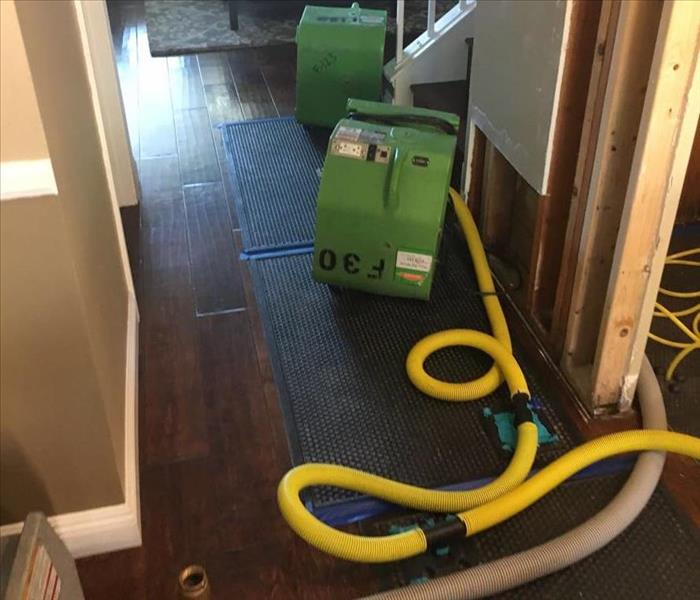 Our technicians place wood floor recovery mats to dry wood floor affected by a leak of the water line to the fridge.
Our technicians place wood floor recovery mats to dry wood floor affected by a leak of the water line to the fridge.
Hardwood floors are a popular flooring option for many homeowners due to their aesthetic as well as the relatively low maintenance required. While hardwood floors are extremely durable, they can be quite vulnerable to moisture. If your home has hardwood floors, it is important that you are always on the lookout for signs of water damage to the wood flooring.
A very common sign of water damage in hardwood floors in known as cupping. This occurs when moisture causes the wood to expand, which then pushes the boards together and deforms them in the center. Another common sign of water damage in wood floors is called crowning. Crowning is essentially the opposite of cupping. While cupping causes a depression in the center of the wood planks, crowning is when the boards are pushed together and result in a raise in the center of the wood boards. Both cupping and crowning can lead to a buckling floor if left unchecked. Buckling is when the floor boards have actually begun lifting from the subfloor, causing considerable damage to your wood floor.
Other signs to be aware of are if the floor starts to crack, the boards are separating, or the wood becomes soft and weak. If you notice any of these signs occurring in your wood floor, you have wood floor water damage, and need to take action to prevent further damage.
The first step in preventing further water damage is to determine the source of the damage. If you have an active leak, it is best to turn of the water to the home and have a leak detector or plumber inspect to determine the cause of leak and make a repair.
You should also call SERVPRO right away to begin the mitigation services. If the floor is salvageable, we can place drying equipment (including a floor drying mat system) to repair the damaged floor to its preloss condition.
If you think your home may be affected by a water damage, give SERVPRO of Tustin a call today! 714-480-1340
5 Common Causes of Water Damage in Orange County
8/22/2018 (Permalink)
Unlike other parts of the country, rain isn't the main cause of water damage in homes and other buildings in Orange County. Get to know some of the common causes of water damage so that you can do what you can to prevent it from happening on your property.
- Broken Pipes – A broken pipe can do a lot of damage to your home in just a short amount of time. Before you know it, gallons short amount of time. Before you know of water could be spewing through your home. Pay close attention to any leaks, drips, and signs of deterioration. Have a plumber come out to your house for regular maintenance, and if there ever is a broken pipe, you can always turn the water off before the plumber arrives in order to avoid further damage.
- Pinhole Leaks – common if a home has copper plumbing, a pinhole leak is a puncture of a copper pipe due to corrosion. If your home has a copper water system, check your pipes for signs of corrosion often.
- Old/Faulty Appliances – If your fridge or washing machines aren’t maintained well, or have gotten too old, they could start to leak and create a significant amount of water damage in your home. It’s especially important to keep an eye on the appliances in your kitchen, as water damage caused by your fridge or dish washer can affect not just your floor, but your cabinets as well. Often times, leaks that go undetected for some time will cause significant water damage behind cabinets, which in turn can lead to mold if the problem goes unnoticed for an extended period.
- Roof Leaks – We don’t typically see much rain here in Southern California, but when we do, a lot of homeowners tend to suffer water damage due to roof leaks. Check your roofs frequently and take care of any maintenance or repairs while the weather is still sunny. That way you won’t have to worry about your home flooding next time a storm hits.
- Accidents – Sometimes luck just isn’t on your side and one tiny mistake can lead to a big problem. A clogged toilet or too much soap in the dishwasher or washing machine can have water coming across your bathroom, kitchen, or laundry room. These parts of the home are generally better equipped than the rest of the house to handle a larger spill, but water moves fast and could potentially cause damage to the walls, ceiling, or other rooms in the home. If an accident ever does occur that you think calls for a professional, call SERVPRO of Tustin and we’ll make it"Like it never even happened."
(714)480-1340
Prevent These Common Types of Water Damage in the Summer
6/19/2018 (Permalink)
Water damage occurs year round, but there are certain factors that come with every season that you'll want to be extra cautious of when that time of year rolls around. Now that Summer is here, be sure to keep these common types of water damage in mind:
- A/C Overflows - When the air conditioner is in use, a little bit of condensation on the drip pan is normal. If the day is particularly hot and humid however, the drip pan may collect more water/condensation than normal. If the condensation line clogs, the drip pan can overflow rapidly every time the A/C cycles on. Be sure to check on the drip pan every week during the summer. It is normal for it to be wet when A/C is operating, but if you notice standing water in the pan, you should turn off the unit and call a qualified HVAC technician.
- Many people travel during the summer and it is important that you prepare your home before you leave to prevent a water damage from occurring while you're away! The best way you can prevent water damage in your home while you're away is to locate your main water shutoff valve and turn off the water to the house before you go.
Of course there's never a good time for a water damage to occur in your home. If you should experience a water damage however, give SERVPRO of Tustin a call and we'll make it "Like it never even happened."
714-480-1340
What Are You Doing To Prevent Water Damage In Your Tustin Home?
6/27/2017 (Permalink)
We here at SERVPRO of Tustin are experts when it comes to water damage. With over 30 years in the restoration industry, we’ve seen it all. Though our specialty is restoring your home to preloss conditions after you suffer water damage and making it “Like it never even happened,” we have some tips for how you can prevent any future water damage to your home.
Watch Your Water Bill
- So often, homeowners don't realize there's a leak until major damage is done. If your water bill seems unusually high, there may be something going on behind the walls or beneath the floorboards. Monitor your bill closely to catch any potential leaks early.
Investigate Leaks Promptly
- If there is a water leak in your home, it is imperative that you take care of it quickly. Moisture in your home that is left untreated can result in mildew or mold and even structural damage to your property. Additionally, water damage that isn't treated within 48 hours could potentially become contaminated.
Be Careful Where (And What) You Plant
- Some plants, such as willows, elms, and maples, have invasive roots that could cause problems for your property. Before planting a tree, find out about its root system. Never plant a tree less than 10 ft. from your home's foundation; trees with invasive roots may need to be even further (25 to 50 ft. away) in order to ensure the roots don't damage your water and sewer lines.
Ensure Proper Drainage
- Clear your gutters regularly to make room for rain water. Downspouts from your gutters should be directed at least 5 ft. away from your home. It is best to have the water flow onto a hard surface (such as a driveway) or to have a splash guard designed to spread the water and keep it from puddling on the ground.
Check Home Appliances Regularly
- Oftentimes, flooding in the home is caused by a leak from a fridge or dishwasher, etc. Check and maintain your home's appliances regularly, and follow the manufacturer's directions to fix any possible leaks. It is also a good idea to regularly replace the hose for your washing machine. Leaky hoses are a common cause of residential water damage.
Of course these are just some ways to prevent water damage. Unfortunately, not all forms of water damage are preventable. Disaster can strike at any moment, no matter how prepared you may be. We hope it doesn't happen to you, but if it does, call SERVPRO of Tustin and we'll make it "Like it never even happened."
714-480-1340
Understanding The Three Categories Of Water
6/19/2017 (Permalink)
When dealing with water damage in your home or business, there are three different types or classifications of water that we use: Clean, Gray, and Black water.
Clean Water: This is water that does not contain contaminants. It includes broken water lines, malfunctioning appliances, toilets holding tanks, snow melt and rainwater. Overtime however, clean water can progress and become gray water within 48 hours, if left untreated.
Gray Water: Gray water does contain slight chemical or biological contaminants, and may pose a health risk. Gray water can discharge from dishwashers, washing machines, sinks, showers, aquariums and waterbeds, or come from a clean water source that leaked through a ceiling. It can also be clean water that was left untreated (and became gray water). Gray water can also progress to the next stage (Black Water) if left untreated within 48 hours.
Black Water: This water is a positive health risk as it is highly contaminated. Black water is presumed to contain multiple potentially harmful contaminants including fungi, bacteria, chemicals, viruses, and more. Black Water is typically caused by sewage damage, flooding, or any type of natural disaster. Black water should always be treated by a trained and certified professional.
For any type of water damage, it is always best to treat it quickly so as to avoid further contamination and risk mold growth. Call SERVPRO of Tustin if you need services in your home! Available 24/7 (714)480-1340
SERVPRO of Tustin is an IICRC certified firm.






 24/7 Emergency Service
24/7 Emergency Service
